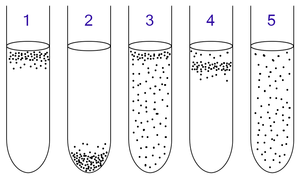


Amicroaerophile is a microorganism that requires environments containing lower levels of dioxygen than that are present in the atmosphere (i.e. < 21% O2; typically 2–10% O2) for optimal growth.[1] A more restrictive interpretation requires the microorganism to be obligate in this requirement.[2][3] Many microaerophiles are also capnophiles, requiring an elevated concentration of carbon dioxide (e.g. 10% CO2 in the case of Campylobacter species).[4]
The original definition of a microaerophile has been criticized for being too restrictive and not accurate enough compared to similar categories. The broader term microaerobe has been coined to describe microbes able to respire oxygen "within microoxic environments by using high-affinity terminal oxidase".[1]
Microaerophiles are traditionally cultivated in candle jars. Candle jars are containers into which a lit candle is introduced before sealing the container's airtight lid. The candle's flame burns until extinguished by oxygen deprivation, creating a carbon dioxide-rich, oxygen-poor atmosphere.[5]
Newer oxystat bioreactor methods allow for more precise control of gas levels in the microaerobic environment, using a probe to measure the oxygen concentration or redox potential in real time.[6] Ways to control oxygen intake include gas-generating packs and gas exchange.[4]
As oxystat bioreactors are expensive to buy and run, lower-cost solutions have been devised. For example, the Micro-Oxygenated Culture Device (MOCD) is a system involving ordinary flasks, oxygen-permeable tubes, sensors, and water pumps. Aeration is done by pumping the culture medium through the tubes.[1]
A wide variety of microaerobic conditions exist in the world: in human bodies, underwater, etc. Many bacteria from these sources are microaerobes, some of which are also microaerophiles.
|
| |||||||
|---|---|---|---|---|---|---|---|
| Medical microbiology |
| ||||||
| Biochemistry and ecology |
| ||||||
| Shape |
| ||||||
| Structure |
| ||||||
| Taxonomy and evolution |
| ||||||
| |||||||
This microbiology-related article is a stub. You can help Wikipedia by expanding it. |